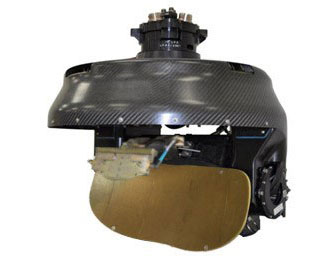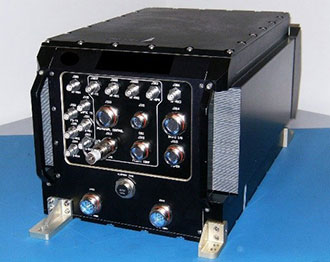Location of the AN/APY-8 Lynx II radar on board the MQ-1 Sky Warrior UAV - designated #1
AN/APY-8 Lynx II (airborne radar)
- AN/APY-8 Block 20 radar (system weight 120 lbs)
- AN/DPY-1 Block 30 radar (system weight < 85 lbs)
Sources of information:
Defense Update 1
Defense Update 2
Electronic Military&Defence
General Atomics Aeronautical Systems
Deagel
Lynx Multi-Mode Radar
Surveillance, Tracking, Targeting for Manned and Unmanned Missions
GA-ASI's Lynx Multi-Mode Radar is a high-performance system that provides high-resolution, photographic-quality imagery that can be captured through clouds, rain, dust, smoke and fog. Designed to meet the onboard challenges of the Remotely Piloted Aircraft (RPA) systems environment, the Lynx radar consumes minimal Size, Weight, and Power (SWAP) while delivering precision air-to-surface targeting accuracy and superb wide-area search capabilities for both ground and maritime missions.
The Lynx Radar consists of two primary LRUs, the REA, which contains the signal generation and reception processing necessary to form a SAR image, as well as the motion measurement system (MOMEAS) necessary to direct the antenna to the designated area and generate a georeferenced SAR image from a moving aircraft. The GAA contains the Radio Power Amplifier, parabolic antenna, gymbal and LNA to amplify signals from the REA for transmission, keep the antenna in the direction commanded by the REA, and amplify the return signal so that it can be processed by the REA. The REA further receives mode and area commands from the ground control station via the platform communications and provides SAR imagery and status or data from other modes to the platform for transmission back to the ground control station.
Lynx features its Synthetic Aperture Radar (SAR), Ground/Dismount Moving Target Indicator (GMTI/DMTI), and robust Maritime Wide Area Search (MWAS) modes. Lynx's search modes provide the wide-area coverage for any integrated sensor suite, allowing for cross-cue to a narrow Field-of-View (FOV) Electro-optical/Infrared (EO/IR) sensor.
Eagle Eye Radar GAA
General Atomics Aeronautical Systems, Inc. (GA-ASI), a leader in Multi-mode Radar technology for Unmanned Aircraft Systems, introduces the EagleEye radar. The EagleEye Multi-Mode Radar (MMR) delivers revolutionary new sensing and versatility for the latest generation of unmanned aircraft and other high-demand users. Equipped with a variety of modes and features, EagleEye not only provides deep and detailed performance in specific applications but also spans many operating environments, including coastal perimeters and open water, with its Maritime Wide Area Surveillance (MWAS) mode.
Moving target indication, SAR change detection, stripmap, spotlight, and other functions provide warfighters with precise, relevant, and actionable battlefield awareness. EagleEye’s synthetic aperture radar, or SAR, lets it look through clouds, dust, haze, smoke, and other challenging conditions to generate detailed photo-like images. Inverse SAR mode uses the motion of the object to yield images of it – ideal for ships at sea against the flat ocean. And with a new video SAR mode, the system can show full-motion images of what it sees to increase the speed of detection and analysis of objects, events, and threats. The new MMR is installed and has flown on a U.S. Army-operated Gray Eagle Extended Range (GE-ER) UAS. EagleEye joins GA-ASI’s line of radar products, which includes the Lynx® MMR.
EagleEye is a high-performance radar system that delivers high-resolution, photographic-quality imagery that can be captured through clouds, rain, dust, smoke and fog at multiple times the range of previous radars. It’s a “drop-in solution” for Gray Eagle ER and is designed to meet the range and accuracy to Detect, Identify, Locate & Report (DILR) stationary and moving targets relevant for Multi-Domain Operations (MDO) with Enhanced Range Cannon Artillery (ERCA). EagleEye radar can deliver precision air-to-surface targeting accuracy and superb wide-area search capabilities in support of Long-Range Precision Fires.
Featuring Synthetic Aperture Radar (SAR), Ground/Dismount Moving Target Indicator (GMTI/DMTI), and robust Maritime Wide Area Search (MWAS) modes, EagleEye’s search modes provide the wide-area coverage for any integrated sensor suite, allowing for cross-cue to a narrow Field-of-View (FOV) Electro-optical/Infrared (EO/IR) sensor.
The EagleEye’s first flight on the Army GE-ER aircraft took place in December, incorporating the new Video SAR capability. Video SAR enables continuous collection and processing of radar data, allowing persistent observation of targets day or night and during inclement weather or atmospheric conditions. In addition, EagleEye’s processing techniques enables three modes – SAR Shadow Moving Detection, SAR Stationary Vehicle Detection and Moving Vehicle Detection as part of its Moving Target Indicator – to operate simultaneously.
“The Video SAR in EagleEye provides all-weather tracking and revolutionizes precision targeting of both moving and stationary targets at the same time,” said GA-ASI Vice President of Army Programs Don Cattell. “This is a critical capability in an MDO environment to ensure military aviation, ground force and artillery have constant situational awareness and targeting of enemy combatants.”
FEATURES/BENEFITS
- All-in-One Solution: True multi-mission capability from a single low-cost/low-SWAP radar package
- Technical Readiness Level 9: GA-ASI multi-mode radars are fielded on over 500 manned and unmanned aircraft
- Ease of Use: Intuitive user interface with mission-centric command and control
- All-Weather Imaging: Generate extremely high-resolution photographic-like imagery and perform long-range precision targeting using spotlight, stripmap, and brickmap SAR
- Moving Target Tracking: Detect and track ground movers using DMTI and GMTI modes
- SAR Full Motion Video: Simultaneously image, detect, and track stationary and moving ground objects from intuitive EO/IR-like SAR video with unprecedented situational awareness and target geo-location accuracy
- Maritime Surveillance with ISAR Imaging: Quickly detect, track, and classify challenging maritime vessels in blue water or littoral environments
- Processing/Exploitation/Dissemination: Change detection; automatic manmade object detection;
- pattern-of-life analysis; compliant with STANAG and NITF data standards
- Situational Awareness: Artificial intelligence/mabhine learning-enabled target detection, classification, and automation
SPECIFICATIONS
| Maritime Surveillance with ISAR Imaging |
| Ground Moving Target Tracking (GMTI) |
| SAR Imaging with Precision Targeting |
Performance
FIELD OF VIEW: -5° to -60° El, ±180° Az (configurable)
- SAR RESOLUTIONS: Very fine to 3 m
- SAR RANGE: Up to 80 km (50 mi)
- MTI RANGE: Up to 60 km (38 mi)
- MARITIME SURVEILLANCE RANGE: Up to 200 km (125 mi)
- ISAR RANGE: Up to 150 km (93 mi)
Size Weight Power, and Environmental
- TOTAL WEIGHT: < 62 kg (137 lb)
- INPUT POWER: 28 Vdc, 1.9 kW peak, 1.4 kW average
- TRANSMIT POWER: 360W peak, 35% duty cycle
- FREQUENCY: 2-channel Ku-band with 3 GHz bandwidth
- COOLING: Operates from -55° to +50°C (sealed conduction cooling)






No comments:
Post a Comment